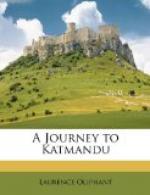On the opposite side to that on which the Durbar was situated were two temples: one of them, built of grey sandstone, was an imposing structure, altogether different from any building, lay or ecclesiastical, that I had ever seen before. The lower story consisted of massive verandahs or cloisters; the pillars were all of grey sandstone, very simple in form; and the connecting arch was somewhat Saracenic in its appearance. The temple was square, and the corridor which ran round it was elevated considerably above the level of the court: the ascent to it was by two flights of steps, each guarded by a pair of sculptured winged lions. Three stories of light belfry-like temples, three upon each side of the square, surmounted each other in rows; in the centre was a mass of architecture between a dome and a spire, rising to a height of upwards of 100 feet above the level of the court: the whole formed a pyramidal structure ornamented with fantastic devices, and undoubtedly Bhuddist in its character.
The other temple was a two-storied pagoda; its bright colours were faded, and it appeared far inferior to those of more recent construction. There were also ruined pyramidal shrines of no known architecture, and difficult to describe from their complicated nature—antique specimens of the masonry of ages long gone by, and memorials of a religion doubtless impure, although Bhuddist in its character and origin.
No less singular were the residences of the old Newar nobility, a race which no longer exists, and the only remains of which now extant are their ruined habitations, evidently destined to succumb before long to the same all-destroying power which has long since obliterated every trace of their former owners.




